Rising Economic Mobility in Pakistan
By Riaz Haq
CA
A 2012 study of 22 nations conducted by Prof Miles Corak for the Organization for Economic Cooperation and Development (OECD) has found income heritability to be greater in the United States, the United Kingdom, Italy, China and five other countries than in Pakistan.
The study's findings, presented by the author in testimony to the US Senate Finance Committee on July 6, 2012, rely on the computation of "inter-generational earnings elasticity" which the author explains as follows:
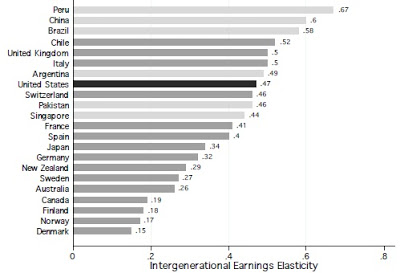
"(It) is the percentage difference in earnings in the child’s generation associated with the percentage difference in the parental generation. For example, an intergenerational elasticity in earnings of 0.6 tells us that if one father makes 100% more than another then the son of the high income father will, as an adult, earn 60% more than the son of the relatively lower income father. An elasticity of 0.2 says this 100% difference between the fathers would only lead to a 20% difference between the sons. A lower elasticity means a society with more mobility."
Intergenerational Mobility in Pakistan:
Corak calculates that the intergenerational earnings elasticity in Pakistan is 0.46, the same as in Switzerland. It means that a difference of 100% between the incomes of a rich father and a poor father is reduced to 46% difference between their sons' incomes. Among the 22 countries studied, Peru, China and Brazil have the lowest economic mobility with inter-generational elasticity of 0.67, 0.60 and 0.58 respectively. The highest economic mobility is offered by Denmark (0.15), Norway (0.17) and Finland (0.18).
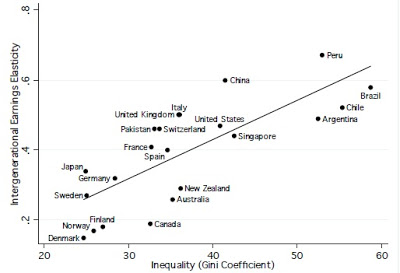
The author also looked at Gini coefficient of each country and found reasonably good correlation between Gini and intergenerational income elasticity.
In addition to Corak, there are other reports which confirm that Pakistan has continued to offer significant upward economic and social mobility to its citizens over the last two decades. Since 1990, Pakistan's middle class had expanded by 36.5% and India's by only 12.8%, according to an ADB report titled "Asia's Emerging Middle Class: Past, Present And Future".
More evidence of upward mobility is offered by recent Euromonitor market research indicating that Pakistanis are seeing rising disposable incomes. It says that there were 1.8 million Pakistani households (7.55% of all households) and 7.9 million Indian households (3.61% of all households) in 2009 with disposable incomes of $10,001 or more. This translates into 282% increase (vs 232% in India) from 1995-2009 in households with disposable incomes of $10,001 or more. Consumer spending in Pakistan has increased at a 26 percent average pace the past three years, compared with 7.7 percent for Asia, according to Bloomberg .
Mobility Drivers:
The study identified three key drivers of inter-generational mobility: Family, Labor Market and State.
The biggest difference the family makes is in terms of education and training of the children. Growing labor market is important for the availability of better paying jobs, and the state matters because its policies influence access to education and growth of economic opportunities. For Pakistanis, the weakest link here has been the state which has failed to adequately fund education and facilitate economic growth through infrastructure investments. The private sector, the civil society and the international community have, however, stepped in to at least partially compensate for some of the most serious shortcomings of the state.
Education:
Pakistani parents are taking education more and more seriously and enrolling their children at all levels. According to Harvard University researchers Robert Barro and Jhong-Wa Lee , Pakistan has been increasing enrollment of students in schools at a faster rate since 1990 than India. In 1990, there were 66.2% of Pakistanis vs 51.6% of Indians age 15 and above who had no schooling. In 2000, there were 60.2% Pakistanis vs 43% Indians with no schooling. In 2010, Pakistan reduced it to 38% vs India's 32.7%.
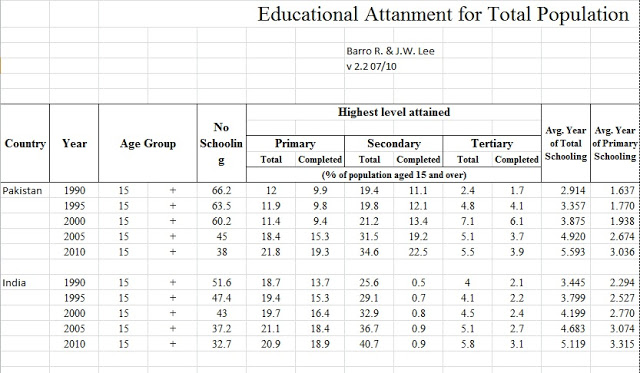
As of 2010, there are 380 (vs 327 Indians) out of every 1000 Pakistanis age 15 and above who have never had any formal schooling. Of the remaining 620 (vs 673 Indians) who enrolled in school, 22 (vs 20 Indians) dropped out before finishing primary school, and the remaining 598 (vs 653 Indians) completed it. There are 401 (vs 465 Indians) out of every 1000 Pakistanis who made it to secondary school. 290 (vs 69 Indians) completed secondary school while 111 (vs. 394 Indians) dropped out. Only 55 (vs 58 Indians) made it to college out of which 39 (vs 31 Indians) graduated with a degree.
Labor Market:
Pakistan's employment growth has been the highest in South Asia region since 2000, followed by Nepal, Bangladesh, India, and Sri Lanka in that order, according to a recent World Bank report titled "More and Better Jobs in South Asia" .
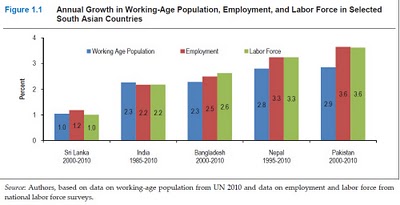
Total employment in South Asia (excluding Afghanistan and Bhutan) rose from 473 million in 2000 to 568 million in 2010, creating an average of just under 800,000 new jobs a month. In all countries, except Maldives and Sri Lanka, the largest share of the employed are the low ‐ end self-employed.
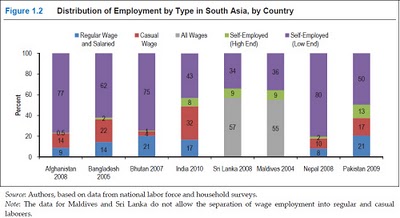
The report says that nearly a third of workers in India and a fifth of workers in Bangladesh and Pakistan are casual laborers. Regular wage and salaried workers represent a fifth or less of total employment.
Analysis of the labor productivity data indicates that growth in TFP (total factor productivity) made a larger relative contribution to the growth of aggregate labor productivity in South Asia during 1980–2008 than did physical and human capital accumulation. In fact, the contribution of TFP growth was higher than in the high ‐ performing East Asian economies excluding China.
Summary:
The experience of OECD nations shows that construction of a large and vibrant middle class is an absolutely essential pre-requisite for a prosperous and democratic society. In spite of all of its current difficulties, Pakistan's middle class is growing as evident from data coming from a variety of sources ranging from ADB and the World Bank to university researchers and Euromonitor consumer research firm. More enlightened leadership in Islamabad can help accelerate this process by focusing greater attention to raising more revenue and increasing public investment in education, health care and infrastructure.
--------------------------------------------------------------------
Back to Pakistanlink Homepage

